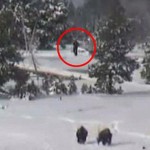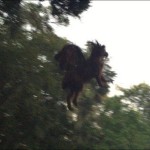Does the Jackalope Really Exist?
A Jacka- what? This mythical creature is thought to just be an American creation, but is its existence rooted in some fact?
The Jackalope is an American creation from the 1930’s by a taxidermist located in Colorado, that decided to place deer horns on a rabbit, hence creating the Jackalope. The Jackalope can also have Antelope horns placed on a rabbit thus creating the name. Rabbits, since the mid 1930’s have been found with a rare virus that creates small ‘horn’ like structures on the face.
Legend
The jackalope is subject to many outlandish and largely tongue-in-cheek claims as to its habits. Given the pseudo-taxonomic descriptor Lepus temperamentalus, it is said to be a hybrid of the pygmy-deer and a species of “killer rabbit”. Reportedly, jackalopes are extremely shy unless approached, and, if approached, they are dangerous.
Like Jackalopes? Jackalope Bunny Rabbit Lifelike Decoration Model Collectible Figurine
Legend also has it that female jackalopes can be milked—as they sleep belly up—and that the milk can be used for a variety of medicinal purposes. One of the few ways a jackalope can be caught is by leaving out a bottle of whiskey, as it is the jackalope’s sustenance of choice. It has also been said that the jackalope can convincingly imitate any sound, including the human voice.
It uses this ability to elude pursuers, chiefly by using phrases such as “There he goes! That way!” During days of the Old West, when cowboys gathered by the campfires singing at night, jackalopes could often be heard mimicking their voices. It has also been said that jackalopes will only breed during winter electrical storms, explaining their rarity.
Check Out This American Classic! TCM Greatest Classic Films Collection: John Wayne Westerns (The Cowboys / Fort Apache / Rio Bravo / The Searchers)
Medical Explination
The cottontail rabbit papilloma virus (CRPV), or Shope papilloma virus, is a type I virus under the Baltimore scheme, possessing a nonsegmented dsDNA genome. The virus was originally separated from horny warts on cottontail rabbits by Dr. Richard E. Shope in 1933. It infects rabbits, causing keratinous carcinomas, typically on or near the animal’s head. These tumors can become large enough that they interfere with the host’s ability to eat, eventually causing starvation.
Shope papilloma virus provided the first mammalian model of a cancer caused by a virus. It takes its name from Dr. Richard E. Shope, who discovered it in the 1930s. Shope was able to isolate virus particles from tumors on captured animals and use these to inoculate domestic rabbits, which then developed similar tumors. The virus was sequenced in 1984, showing substantial sequence similarities to HPV1a. It has been used as a model for human papillomaviruses both before and after this discovery. The most visible example of this role is the HPV vaccine, which was developed based on and incorporating research done using the virus as a model. Similarly, it has been used to investigate antiviral therapies.
Once again myth and legend has roots traced back to a realistic source, putting this American Myth finally to rest.






